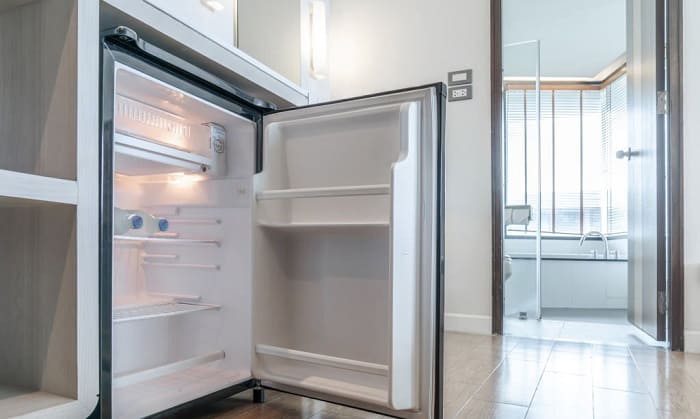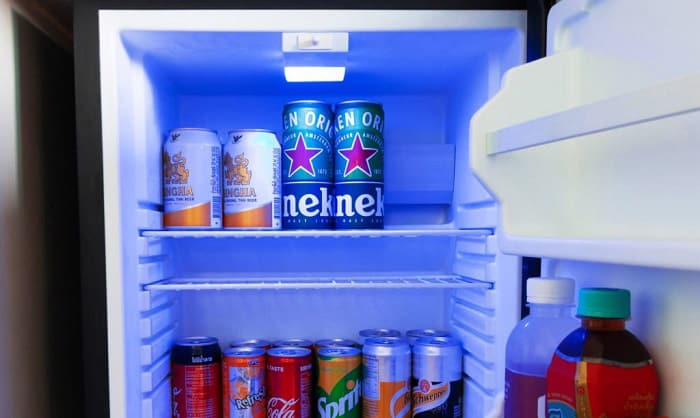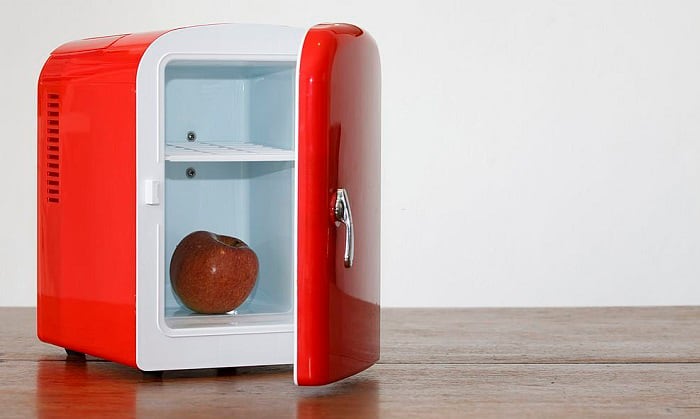Since your typical refrigerator doesn’t always reveal how many amps it pulls in its product description, I get that a lot of people are asking, “How many amps does a mini fridge use?”
The average mini fridge amp draw hovers between 2 amps and 5 amps at 120 volts. But if you want to get a more precise figure, there’s no better way than to use the formula:
\begin{equation}
\text{Amps} = \frac{\text{Watts}}{\text{Volts}}
\end{equation}
Figuring out the amperage will be easy if the manufacturer discloses it in the appliance’s manual or nameplate, assuming you already own a small refrigerator. To be specific, look at the number marked as “Rated Current.”
Table of Contents
How Many Amps Does a Mini Fridge Pull?
The average 2 amp mini fridge clearly saves way more energy use in a day than, let’s say, a standard-sized residential refrigerator.
Since the latter’s bigger in capacity, the amp draw on refrigerator with such a large surface area (often represented in cubic feet) will inevitably be higher. For context, consider the fact that such refrigerators pull 15A on average.
As you can see from the amps and watts ratings (if you compare mini fridge options available to you), you can still get models that are more efficient than others. By that, I mean units that draw only a little over 2A even at peak watts usage or those that use even less at 1.1A.
Don’t be surprised if that’s the case for a unit that’s marketed for energy efficiency, as proven by its Energy Star certification.
Also, don’t confuse amp per hour (amp-hour) with amp draw.
- Amp-hour (Ah) denotes the amount of current that a battery can provide per hour.
- Amp draw reflects the total power consumption of a motor, particularly one that’s used in HVAC systems. In refrigerators, it means the amount of current consumed by compressors to properly cool the fridge interior.
It’s also important to point out that small refrigerators have varying amp draws during certain points of their operation.
Here’s a Sample Measurement from Real Life
For example, I once measured the mini fridge watts of my personal cooler while it was running using a wattmeter. It read 33 watts. Since it was rated for 230 volts, I followed the formula above and arrived at:
\begin{equation}
\frac{\text{33 Watts}}{\text{230 Volts}} = 0.14\text{A}
\end{equation}
That’s mighty efficient! Plus, it’s not really a surprise since most modern units are designed to keep their power consumption low when they’re idle. This is especially true if they remain unopened and the compressor doesn’t need to kick in.
However, what we really need to be looking at if we want to confirm the number on the plates is the amp draw when starting the motor. Why? Because starting the refrigerant requires the most power and (inrush) current.
For my model, it peaked at 900 watts, which, following the same formula above, gives us 4A.
That still falls well within the usual range of 2A to 5A I mentioned above, although 230V units are obviously more efficient. If the mini fridge voltage had been 110V instead, we’d have doubled that amount to 8A, to be exact.
So, in the end, there are definitely plenty of variations to consider, particularly how many volts the unit is rated for, the small fridge wattage at startup, and its size as measured in cubic feet.
Mini Fridges Models and Their Respective Amp Usages
If you look in online stores, a mini fridge’s capacity is often readily displayed in “cu ft”, while some models use liters. Any refrigerator counts as a compact fridge as long as its size doesn’t exceed 6 cubic feet.
The fridge’s capacity draws the line between standard and mini models and is directly related to its rated current. Hence, we’ll use cubic feet to classify common units.
Use the information below as a general overview of the average amp draws of most models you can come across nowadays. You’ll see the variables mentioned above come into play more clearly by going through this list. I assume that they’re all rated for 120V.
- A 1.7 cu ft model may draw 6A on average, but one that is 120 watts will have exactly 1A.
- A 2.5 cu ft compact Frigidaire fridge that is marketed as having “low energy consumption” and is rated for 65 watts of power will draw 0.5A.
- A 3.3 cu ft Hisense that uses 100 watts will consume up to 0.8A.
- That is highly similar to a 5 cu ft refrigerator made by Everchill that I’ve seen in a buddy’s trailer. That one only pulls 96 watts, so it also tops out at around 0.8A.
Take note that these calculations don’t factor in the startup watts needed by the fridge’s motor. You can try turning off your fridge completely and letting all its cold dissipate then turning it on again, for example.
Again, it’s better to rely on a wattmeter, so you can be sure you’re getting verifiable values, then perform your own calculations from there.
Here’s a video guide on how you can use one:
What’s clear from the examples I’ve given above, though? For one, just because a model is 1.7 cu ft doesn’t mean that it will have a lower amp draw than a larger 4.5 cu ft fridge. If the current rating is one of your primary concerns, you shouldn’t skip performing these calculations.
Once you’re done calculating, I suggest you go the extra mile and ask the manufacturer about the actual amperage consumption, so you can confirm once and for all the numbers.
Typical Watts and Voltages of Mini Refrigerators
In the US, most small refrigerators and your average mini freezer are rated for 110V or 120V, but there are some places where you can get 220V and 230V, too.
As is evident from the samples above and if you take the time to look through models in online stores, wattage is a different story. At best, we get a minimum of at least 50 watts up to a little over 100 watts.
In short, it changes as much as the usual amps for fridge, TV, a small microwave, or most appliances, for that matter.
While Wh and kWh are more reliable metrics for figuring out mini fridge power consumption, being aware of your model’s amp draw with voltage and watts factored in also gives you a good idea about its energy efficiency.
FAQs
Can I run a refrigerator on a 15 amp circuit?
Considering the average max draw of a standard refrigerator is 15A, this shouldn’t be a problem at all. However, the maximum current can reach 20A.
As confirmed in the latest publication of the National Electric Code, a fridge needs to have its own dedicated circuit, much like any power-hungry appliance you possess.
Does a mini fridge pull a lot of electricity?
Not really, as most compact fridges don’t pull over 250 kWh of electricity annually.
Factoring in the expected average 14.26 cents/kWh power cost in the US in 2022 and assuming your model is consuming 200 kWh every year, you’ll be paying $28.5 annually.
That arguably takes a far lighter toll than, let’s say, an air conditioner, heater, or a standard-sized fridge.
Conclusion
To sum up my answer to “How many amps does a mini fridge use?”:
- The amperage tends to fluctuate, depending on the unit’s present current demands (i.e. whether it’s just starting up or running steadily).
- Look at the nameplate to get a fixed figure that’s backed by the manufacturer.
- Assuming the watts aren’t readily provided, perform the calculations you need by measuring the watts using a wattmeter while minding the voltage.
If you also are wondering other home devices use how many amps, don’t hesitate to visit the following article:

I am Edwin Jones, in charge of designing content for Galvinpower. I aspire to use my experiences in marketing to create reliable and necessary information to help our readers. It has been fun to work with Andrew and apply his incredible knowledge to our content.



